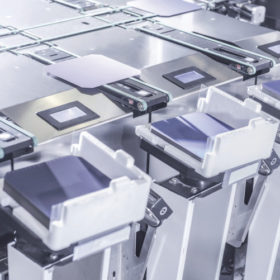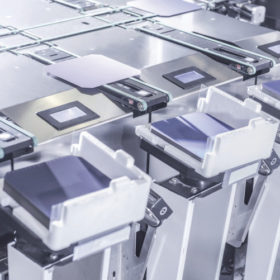Meyer Burger mulls gigawatt-scale German solar fab

Chief executive Gunter Erfurt told a German radio station a solar factory in North Rhine-Westphalia could supply high-efficiency panels for a 10 GW floating solar project on the vast Hambach open-cast coal mine.
From pv magazine Germany.
Swiss solar production equipment maker Meyer Burger is considering establishing a manufacturing facility for its high-efficiency PV cells and modules in Germany, chief executive Gunter Erfurt told German broadcaster Radio Ruhr at the weekend.
The solar equipment maker, which has been hammered by low margins on its products in the Far East, last year formed strategic partnerships with Norwegian solar module maker REC Group and the Oxford PV tech company spun out of Oxford University. The aim of the collaborations was to bring Meyer Burger’s heterojunction-based solar technology to market.
Although Meyer Burger boss Erfurt told the radio station the location of any German production line was yet to be determined, he appeared to have a clear idea of where the products made there might initially be deployed: at the sprawling Hambach open-cast coal mine in Germany’s North Rhine-Westphalia.
Coal-to-solar
A floating solar project at the huge site could, with Meyer Berger’s high-efficiency solar tech, have a generation capacity of 10 GW, according to Erfurt. The CEO explained that was equivalent to the capacity of the Weisweiler, Neurath, Niederaußem and Frimmersdorf coal-fired power plants in the region, ensuring the area could remain an important generation center after the energy transition. Erfurt offered a hint of where the proposed Meyer Burger factory would be located by stating panels installed at Hambach could be “made in North Rhine-Westphalia.”
Erfurt said a floating project at the former mine could replace some of the 10,000 jobs expected to be lost in the local coal industry and would reduce evaporation from what is the largest lake in North Rhine-Westphalia. The regional government has voiced interest in such a scheme, Erfurt added.
The German government has agreed to phase out coal by 2038, although it still has to finalize the details of how that will be achieved.
At the end of 2018, Hamburg-based green electricity provider Greenpeace Energy offered to buy electric utility RWE’s lignite division in a bid to close down coal-fired power plants in the ‘Rheinische Revier’ area by 2025 and replace them with 8.2 GW of solar and wind project capacity. The bid was rejected by the power company.


